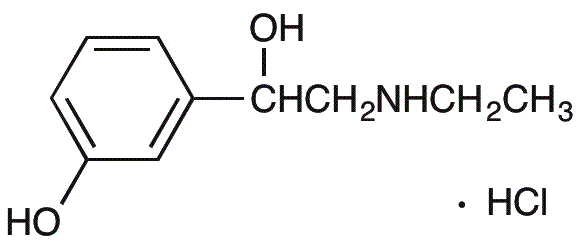Etilefrine hydrochloride is widely utilized in research focused on:
- Cardiovascular Treatments: This compound is often used to manage low blood pressure in patients, particularly during surgical procedures or in cases of orthostatic hypotension, providing a critical option for healthcare professionals.
- Pharmaceutical Development: Researchers leverage etilefrine hydrochloride in the formulation of medications aimed at improving blood circulation, making it essential in the development of new therapeutic agents.
- Clinical Trials: It plays a significant role in clinical studies assessing its efficacy and safety in various patient populations, helping to advance medical knowledge and treatment options.
- Veterinary Medicine: The compound is also applied in veterinary practices to treat similar conditions in animals, showcasing its versatility across different fields of medicine.
- Research on Sympathomimetic Effects: It is used in studies investigating the pharmacological effects of sympathomimetics, aiding researchers in understanding their mechanisms of action and potential applications.
General Information
Properties
Safety and Regulations
Applications
Etilefrine hydrochloride is widely utilized in research focused on:
- Cardiovascular Treatments: This compound is often used to manage low blood pressure in patients, particularly during surgical procedures or in cases of orthostatic hypotension, providing a critical option for healthcare professionals.
- Pharmaceutical Development: Researchers leverage etilefrine hydrochloride in the formulation of medications aimed at improving blood circulation, making it essential in the development of new therapeutic agents.
- Clinical Trials: It plays a significant role in clinical studies assessing its efficacy and safety in various patient populations, helping to advance medical knowledge and treatment options.
- Veterinary Medicine: The compound is also applied in veterinary practices to treat similar conditions in animals, showcasing its versatility across different fields of medicine.
- Research on Sympathomimetic Effects: It is used in studies investigating the pharmacological effects of sympathomimetics, aiding researchers in understanding their mechanisms of action and potential applications.
Documents
Safety Data Sheets (SDS)
The SDS provides comprehensive safety information on handling, storage, and disposal of the product.
Product Specification (PS)
The PS provides a comprehensive breakdown of the product’s properties, including chemical composition, physical state, purity, and storage requirements. It also details acceptable quality ranges and the product's intended applications.
Certificates of Analysis (COA)
Search for Certificates of Analysis (COA) by entering the products Lot Number. Lot and Batch Numbers can be found on a product’s label following the words ‘Lot’ or ‘Batch’.
Número de catálogo
Número de lote/lote
Certificates Of Origin (COO)
This COO confirms the country where the product was manufactured, and also details the materials and components used in it and whether it is derived from natural, synthetic, or other specific sources. This certificate may be required for customs, trade, and regulatory compliance.
Número de catálogo
Número de lote/lote
Safety Data Sheets (SDS)
The SDS provides comprehensive safety information on handling, storage, and disposal of the product.
DownloadProduct Specification (PS)
The PS provides a comprehensive breakdown of the product’s properties, including chemical composition, physical state, purity, and storage requirements. It also details acceptable quality ranges and the product's intended applications.
DownloadCertificates of Analysis (COA)
Search for Certificates of Analysis (COA) by entering the products Lot Number. Lot and Batch Numbers can be found on a product’s label following the words ‘Lot’ or ‘Batch’.
Número de catálogo
Número de lote/lote
Certificates Of Origin (COO)
This COO confirms the country where the product was manufactured, and also details the materials and components used in it and whether it is derived from natural, synthetic, or other specific sources. This certificate may be required for customs, trade, and regulatory compliance.

